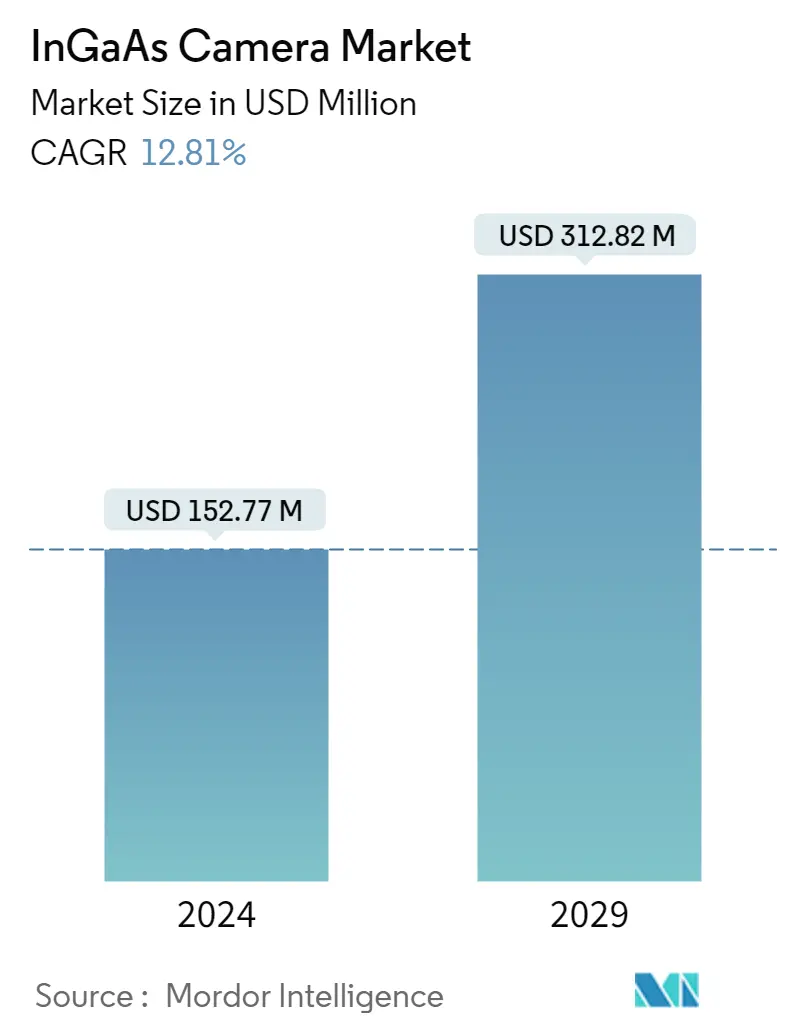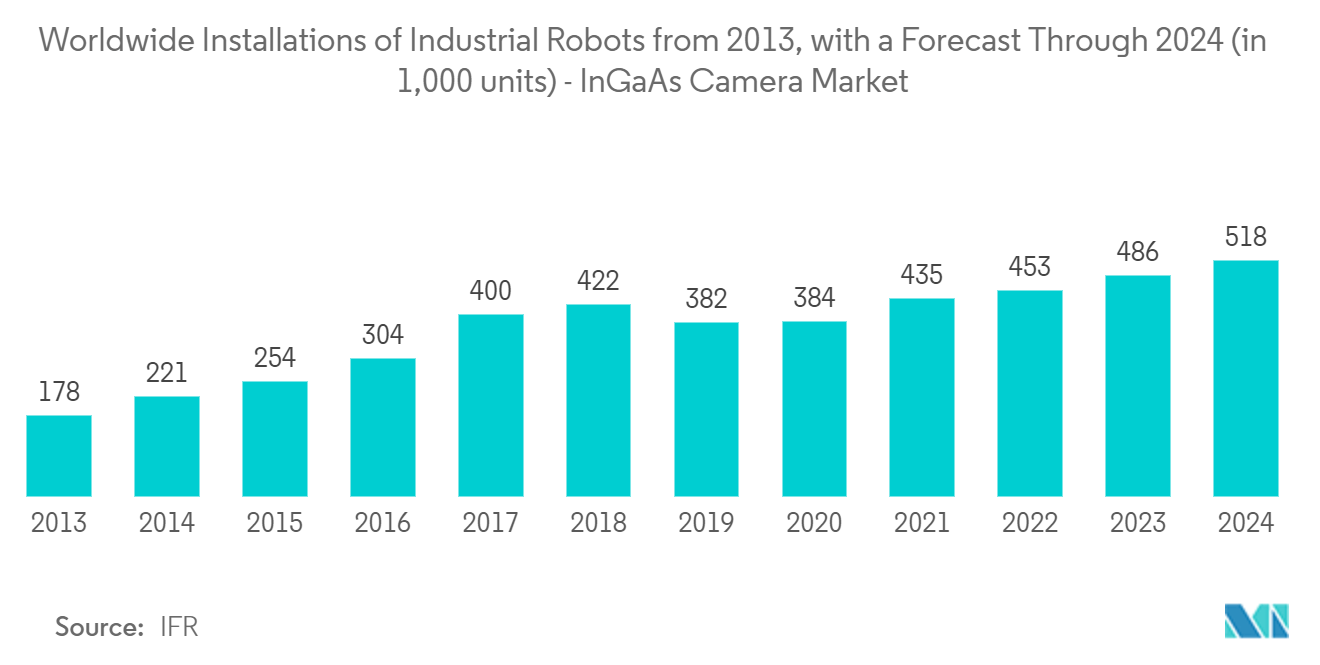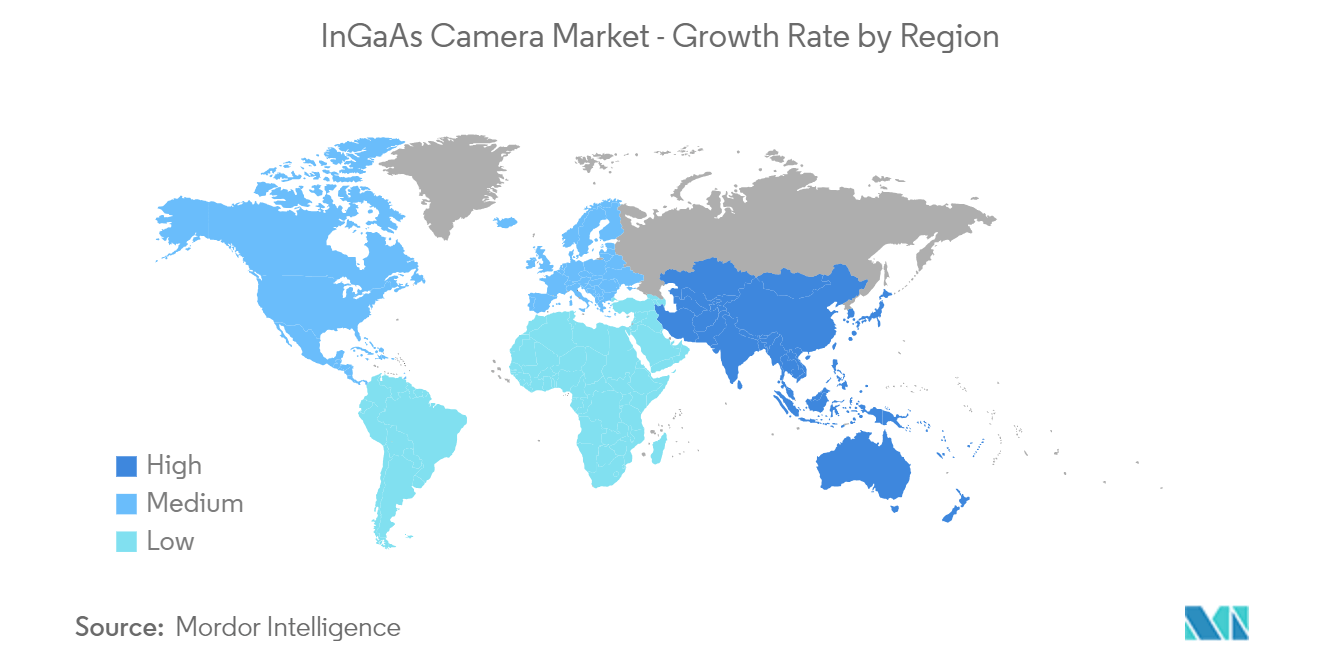InGaAs Camera Market Size

| Study Period | 2019 - 2029 |
| Market Size (2024) | USD 152.77 Million |
| Market Size (2029) | USD 312.82 Million |
| CAGR (2024 - 2029) | 12.81 % |
| Fastest Growing Market | Asia Pacific |
| Largest Market | North America |
Major Players.webp)
*Disclaimer: Major Players sorted in no particular order |
InGaAs Camera Market Analysis
The InGaAs Camera Market size is estimated at USD 152.77 million in 2024, and is expected to reach USD 312.82 million by 2029, growing at a CAGR of 12.81% during the forecast period (2024-2029).
The increasing adoption of automation solutions, such as vision-guided robotic systems, and the increasing use of these cameras for contamination and defect detection are among the significant factors driving the growth of the studied market.
- InGaAs is an III-V compound semiconductor with high photosensitivity in the near-infrared (NIR) and short-wave infrared (SWIR). The InGaAs camera uses this feature in various applications, including real-time in-line non-destructive inspection. The rise in demand for line scan InGaAs cameras for machine vision applications is a crucial driver of the InGaAs camera market.
- InGaAs are cooling-based cameras used in aerospace, military, telecommunications, industrial inspection, and spectroscopy. It has infrared (IR) technology, which allows for night vision or visibility through atmospheric haze and is primarily used by military and defense forces. Because of their performance characteristics, such as small, uncooled, lightweight design, high-quality night vision, attached covert eye-safe lasers, target recognition, and sensitivity to nightglows, these cameras find many applications in defense.
- InGaAs cameras bridge the gap between NIR wavelengths 950-1700 nm, where silicon detectors no longer work, and 950 - 1700 nm, where silicon detectors are no longer sensitive. Because of its lower bandgap, InGaAs provide sensitivity over a more comprehensive NIR range. When compared to Si-CCDs, the lower bandgap is also responsible for a much higher dark current (thermally generated signal). As a result, scientific InGaAs FPA cameras require intense cooling (down to -85°C) to reduce some unwanted noise sources.
- Moreover, as a detector material, InGaAs provided an affordable alternative for near-infrared (NIR) industrial applications such as humidity measurement, surface film distributions, and sorting tasks such as separating polymers from natural materials. As a result, the use of technology in industrial manufacturing and automation is increasing.
- Industry 4.0 accelerated the development of technologies such as robots, which now play a critical role in industrial automation, with robots managing many core operations in industries. New applications for InGaAs cameras include vision-guided robotics and automated butchering. These vision-guided robots are made up of IR imagers that find and pick random parts from a bin, followed by a camera that analyzes the orientation of each part and places it on a conveyor belt.
- Furthermore, the use of machine vision is increasing year after year. Machine vision sales are at an all-time high in some regions. According to the Association for Advancing Automation, machine vision for automated inspection and guidance continued its positive growth trajectory in North America in the first half of 2022, with favorable market growth predicted throughout the year. This is expected to drive demand for InGaAs cameras in such applications during the forecast period.
- However, the higher cost of InGaAs cameras is one of the major factors impeding the growth of the studied market. Furthermore, a rise in stringent import and export regulations across various countries restrains the development of the studied market.
InGaAs Camera Market Trends
Industrial Automation Expected to Occupy the Largest Market Share
- One of the key factors driving market growth is the increasing demand for InGaAs cameras in various applications. Another factor driving market growth is the increasing use of InGaAs cameras in the industrial automation sector. InGaAs cameras are used in industrial automation applications like thermal imaging, machine vision, and quality control because they outperform other types of cameras.
- The increasing adoption of machine vision systems is expected to drive demand for InGaAs cameras in the industrial automation segment. In a machine vision environment, a camera system is used to scan products on a production line. The camera captures the image and compares it to pre-defined criteria.
- Moreover, machine vision is increasingly being used in conjunction with robots to improve their effectiveness and overall value to the business. These robots have a camera mounted at the hand position that guides them through the task at hand. For example, according to IFR's 2023 report, the global stock of operational robots was to reach a new high of approximately 3.5 million units in 2022. In the meantime, the value of installations reached an estimated USD 15.7 billion.
- Furthermore, with the adoption of industrial robots expected to increase over the forecast period, the studied market is expected to see a positive increase in demand from the industrial segment. The annual installation of industrial robots is expected to reach 518 thousand units by 2024, according to IFR.
- Different industries use this technology to automate production and improve product quality and speed. The growing need for high-quality inspection and automation in various industries drives the demand for machine vision, eventually boosting the InGaAs camera market. Furthermore, increased R&D and the launch of new products by InGaAs camera market players are propelling the InGaAs camera market significantly.
- For instance, in January 2023, Lucid Vision Labs unveiled its brand-new 1.3MP and 0.3MP Triton SWIR IP67-rated industrial vision cameras. The Triton SWIR is a GigE PoE camera with wide-band and high-sensitivity Sony SenSWIR 1.3MP IMX990 and 0.3MP IMX991 InGaAs sensors capable of capturing images in visible and invisible light spectrums and a pixel size of 5m.

North America is Expected to Account for the Largest Market Share
- The rising use of robotics like UAVs and UGVs in military and defense applications is expected to increase demand for InGaAs cameras in North America. Moreover, higher penetration of automation and advanced technologies in the industrial domain favors the growth of the studied market in the region.
- The production of machine vision systems will be increased as a result of government programs like the Advanced Manufacturing Partnership, which aims to encourage businesses, academic institutions, and the federal government to invest in cutting-edge automation technologies. This will create a positive outlook for the market's growth.
- As InGaAs cameras are widely used in the military and defense sector to see through unfavorable conditions such as smoke, fog, haze, and water vapor, countries like the United States have increased their defense budgets and expenditure on advanced equipment. For example, a budget request for national defense of USD 813.3 billion in the United States has been made for the fiscal year 2023. Such defense spending is expected to drive market demand.
- Furthermore, the semiconductor industry, where demand for InGaAs cameras in applications such as silicon wafer pattern inspection is increasing, is gaining traction in the North American region, particularly in the United States. Favorable government investments, such as the US CHIPS Act, and vendor investments in the chip industry are thus expected to drive demand for InGaAs cameras during the forecast period.
- InGaAs cameras provide high sensitivity and low noise in medical imaging applications such as optical coherence tomography (OCT) and spectroscopy. Countries such as the United States, Canada, and others are constantly investing in advancing their medical industries, which is expected to drive growth opportunities in the increasing use of InGaAs cameras in medical imaging applications.
- The InGaAs camera market in North America is anticipated to experience favorable growth rates during the anticipated period due to the steadily increasing demand for advanced and effective imaging systems from various end-users operating in the area. Furthermore, advancements in industrial automation with the widespread adoption of robots and government spending in the defense and military industries are expected to drive the market in the coming years.

InGaAs Camera Industry Overview
The InGaAs camera market is competitive due to the market consisting of many large players as well as new players. Companies are trying to innovate their existing products to cater to increasing consumer demand, making the market competitive. Furthermore, the growing demand attracts new players, making the market fragmented. Some of the major players are Allied Vision Technologies GmbH, Acal BFI Limited Company, Coherent Inc., and Flir Systems Inc., among others.
In December 2022, JAI announced the launch of SW-4010Q-MCL, a new industrial prism-based line scan camera featuring 4-sensor line scan technology consisting of multiple CMOS sensors and a sensor based on indium gallium arsenide (InGaAs) technology to collect image data from the short wave infrared (SWIR) spectrum.
In November 2022, Allied Vision announced the launch of four new Goldeye SWIR camera models equipped with an extended range of InGaAs sensors, capable of detecting wavelengths up to 1.9 μm or 2.2 μm at high quantum efficiencies. The integrated dual-stage sensor cooling and several onboard image correction features are among the key factors to make specific spectral features visible with outstanding image quality.
InGaAs Camera Market Leaders
-
Allied Vision Technologies GmbH
-
Acal BFI Limited Company
-
Coherent Inc.
-
Flir Systems Inc.
-
FluxData Inc.
*Disclaimer: Major Players sorted in no particular order
.webp)
InGaAs Camera Market News
- March 2024: SVS-Vistek has introduced two new short wave infrared (SWIR) cameras, the fxo992 and fxo993, to its FXO Series of machine vision cameras. Both the fxo992 and fxo993 cameras utilize Sony's InGaAs SWIR sensors: the IMX992 for the fxo992 and the IMX993 for the fxo993. The IMX992 boasts a resolution of 5.2 MPixels with a frame rate of 132.6 fps, while the IMX993 offers a resolution of 3.1 MPixels and a frame rate of 173.4 fps.
- February 2024: Hamamatsu Photonics, a provider of advanced photonics technology and products, has introduced a new InGaAs camera with sensitivity in the visible to near-infrared region from 400 nm to 1700 nm. The C16741-40U showcases an SXGA resolution of 1280 x 1024 pixels, encompassing both visible and short-wavelength infrared regions. Boasting 5 μm pixels, it excels in capturing high-resolution images with an exceptional signal-to-noise ratio, attributed to its minimized readout noise.
InGaAs Camera Market Report - Table of Contents
1. INTRODUCTION
- 1.1 Study Assumptions and Market Definition
- 1.2 Scope of the Study
2. RESEARCH METHODOLOGY
3. EXECUTIVE SUMMARY
4. MARKET DYNAMICS
- 4.1 Market Overview?
-
4.2 Industry Attractiveness - Porter's Five Forces Analysis
- 4.2.1 Bargaining Power of Suppliers
- 4.2.2 Bargaining Power of Consumers
- 4.2.3 Threat of New Entrants
- 4.2.4 Threat of Substitutes
- 4.2.5 Intensity of Competitive Rivalry
- 4.3 Industry Value Chain Analysis
-
4.4 Technology Snapshot
- 4.4.1 Uncooled
- 4.4.2 Cooled
-
4.5 Market Drivers
- 4.5.1 Increasing Adoption in Machine Vision Applications
- 4.5.2 Rising Demand in Military and Defense Operations
-
4.6 Market Challenges
- 4.6.1 High Procurement Cost of InGaAS Cameras
- 4.6.2 Stringent Regulation on Export and Import
- 4.7 Assessment of Impact of COVID-19 on the Industry
5. MARKET SEGMENTATION
-
5.1 By Application
- 5.1.1 Military and Defense
- 5.1.2 Industrial Automation
- 5.1.3 Surveillance and Security
- 5.1.4 Other Applications
-
5.2 By Geography***
- 5.2.1 North America
- 5.2.1.1 United States
- 5.2.1.2 Canada
- 5.2.2 Europe
- 5.2.2.1 United Kingdom
- 5.2.2.2 Germany
- 5.2.2.3 France
- 5.2.2.4 Italy
- 5.2.3 Asia
- 5.2.3.1 China
- 5.2.3.2 India
- 5.2.3.3 Japan
- 5.2.3.4 Australia and New Zealand
- 5.2.3.5 South East Asia
- 5.2.4 Latin America
- 5.2.5 Middle East and Africa
6. COMPETITIVE LANDSCAPE
-
6.1 Company Profiles
- 6.1.1 Allied Vision Technologies GmbH (TKH group)
- 6.1.2 Acal BFI Limited Company (Discoverie Group PLC)
- 6.1.3 Coherent Inc.
- 6.1.4 Flir Systems Inc.
- 6.1.5 FluxData Inc.
- 6.1.6 Hamamatsu Photonics KK
- 6.1.7 Lambda Photometrics Ltd.
- 6.1.8 New Imaging Technologies
- 6.1.9 Specim Spectral Imaging Ltd.
- 6.1.10 Raptor Photonics Ltd.
- 6.1.11 Sensors Unlimited (Collins Aerospace Company)
- 6.1.12 Teledyne Dalsa Inc. (Teledyne Technologies Incorporated)
- 6.1.13 Xenics Inc.
- *List Not Exhaustive
7. INVESTMENT ANALYSIS
8. MARKET OPPORTUNITIES AND FUTURE TRENDS
** Subject To AvailablityInGaAs Camera Industry Segmentation
InGaAs are cooling-based cameras used in aerospace, military, telecommunications, industrial inspection, and spectroscopy. Because of their performance characteristics, such as small, uncooled, lightweight design, high-quality night vision, attached covert eye-safe lasers, target recognition, and sensitivity to nightglows, these cameras find many applications in defense.
The InGaAs camera market is segmented by application (military and defense, industrial automation, security, and surveillance) and geography (North America, Europe, Asia-Pacific, and the Rest of the World).
The market sizes and forecasts are provided in terms of value (USD) for all the above segments.
| By Application | Military and Defense | |
| Industrial Automation | ||
| Surveillance and Security | ||
| Other Applications | ||
| By Geography*** | North America | United States |
| Canada | ||
| By Geography*** | Europe | United Kingdom |
| Germany | ||
| France | ||
| Italy | ||
| By Geography*** | Asia | China |
| India | ||
| Japan | ||
| Australia and New Zealand | ||
| South East Asia | ||
| By Geography*** | Latin America | |
| Middle East and Africa |
InGaAs Camera Market Research Faqs
How big is the InGaAs Camera Market?
The InGaAs Camera Market size is expected to reach USD 152.77 million in 2024 and grow at a CAGR of 12.81% to reach USD 312.82 million by 2029.
What is the current InGaAs Camera Market size?
In 2024, the InGaAs Camera Market size is expected to reach USD 152.77 million.
Who are the key players in InGaAs Camera Market?
Allied Vision Technologies GmbH, Acal BFI Limited Company, Coherent Inc., Flir Systems Inc. and FluxData Inc. are the major companies operating in the InGaAs Camera Market.
Which is the fastest growing region in InGaAs Camera Market?
Asia Pacific is estimated to grow at the highest CAGR over the forecast period (2024-2029).
Which region has the biggest share in InGaAs Camera Market?
In 2024, the North America accounts for the largest market share in InGaAs Camera Market.
What years does this InGaAs Camera Market cover, and what was the market size in 2023?
In 2023, the InGaAs Camera Market size was estimated at USD 133.20 million. The report covers the InGaAs Camera Market historical market size for years: 2019, 2020, 2021, 2022 and 2023. The report also forecasts the InGaAs Camera Market size for years: 2024, 2025, 2026, 2027, 2028 and 2029.
InGaAs Camera Industry Report
Statistics for the 2024 InGaAs Camera market share, size and revenue growth rate, created by Mordor Intelligence™ Industry Reports. InGaAs Camera analysis includes a market forecast outlook to for 2024 to 2029 and historical overview. Get a sample of this industry analysis as a free report PDF download.



